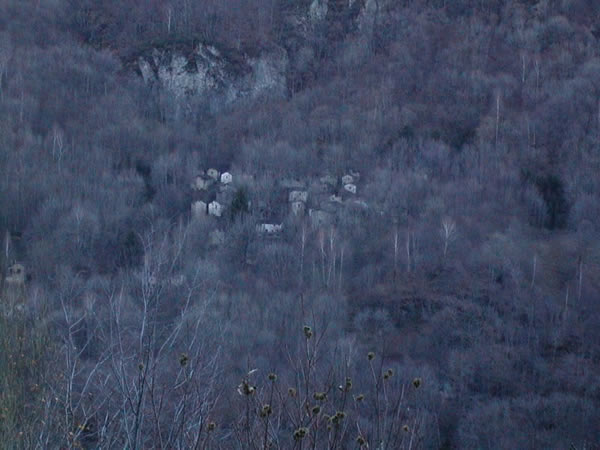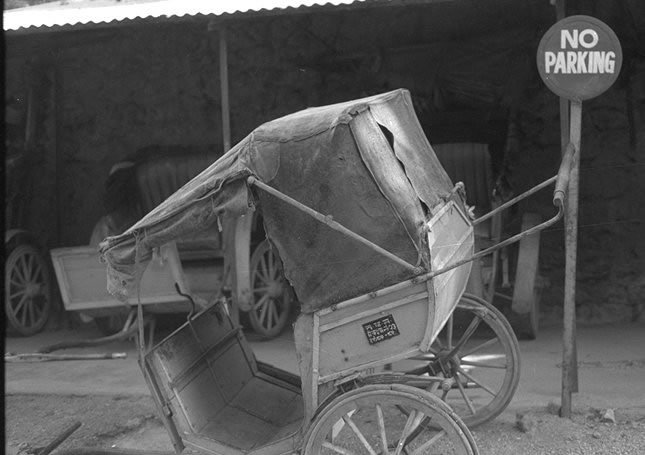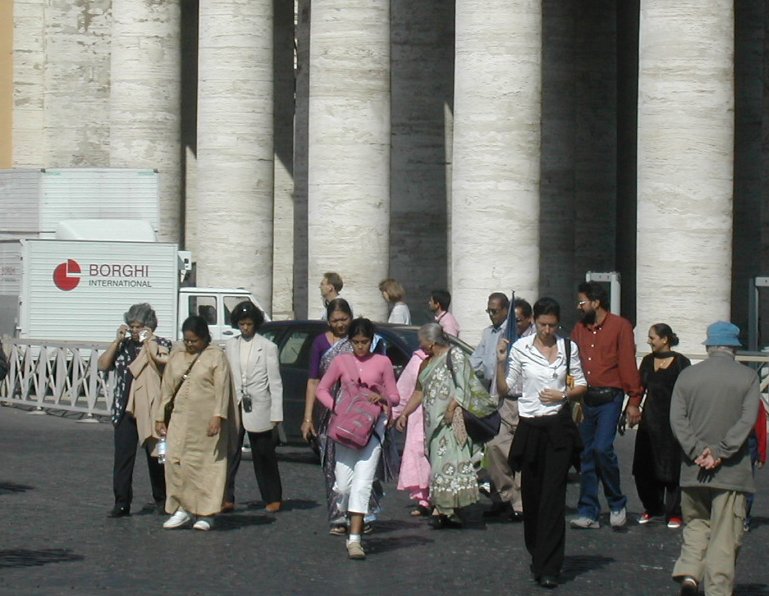I’ve just re-read the latest Harry Potter book, and am re-watching themovies, in anticipation of seeing the latest movie this week (it’s showing in English in Milan: even if there’s only two seconds of Alan Rickman in it, I want to hear his original voice! And I can’t stand the Italian names of the characters).
It struck me that the experience of going off to boarding school (even a non-wizarding one) must be exotic to many people – but it’s familiar to me. Let me count the ways…
Before heading to Woodstock School in India I, too, received a list of required school supplies, which I was advised to pack into a trunk that could be locked, with my name painted on. I don’t remember all the details of the list now, but I do remember being flummoxed by the requirement for warm clothing: we had been living in mostly-tropical Bangladesh for almost a year, and, even had I brought any winter clothes with me, I was a growing teenager. Fortunately, we discovered an open-air market in Dhaka where second-hand clothing donated worldwide to various relief agencies was resold (with or without the agencies’ knowledge?). There I found a couple of sweaters and a pair of jeans. (Wizard’s robes were not on my school list, though the need for formal attire for church was mentioned.)
So far JK Rowling hasn’t told us how students NOT based in London get to Hogwarts. From the fact that they all meet up on the Hogwarts Express, I deduce that they all go to London first, wherever they’re coming from, and then take the school train.
For Woodstock, the situation was a bit more complex: our school had to deal with students coming from Bangladesh, Thailand, the Middle East, Africa, Nepal, the US, and just about everywhere else you could think of (bit more of a cultural mix than Hogwarts!). They tried to arrange for us to arrive on the same flights, but staff nonetheless spent many sleepless nights in Delhi, meeting group after group off the planes. (In those days, India was considered more a stopover than a destination for airlines, so they mostly landed in the middle of the night on their way from Japan to Europe or vice-versa.)
After gathering us into larger groups, which usually involved a day or two at the YWCA in Delhi, the school also arranged our travel up to Mussoorie. By my day, this was mostly in chartered buses, but there were still groups arriving from all over India by train, as they had since 1900 when the railhead reached Dehra Dun (the town in the valley below). Before that, students had travelled by bullock cart and on horseback. Even in the late 1970s, a few whose parents were missionaries in remote corners of Nepal still made the first part of their journey back to school on their own two feet.
There were no lunch trolleys on our buses. Instead, we stopped at Cheetal Deer Park, which didn’t actually have many deer but could whip up the world’s tastiest cheese pakoras for a busload of students in no time flat.
No matter how you reached Dehra Dun, the final leg of the journey was up the narrow, twisty, switchback road to Mussoorie. There’s a point where the air suddenly changes, becoming fresher and cooler and cleaner after the dust of the plains, and a few curves after that you can see Mussoorie, strung out along the ridge at 6000 feet.
The end of the line for buses was (and still is) Picture Palace bus stand – though the Picture Palace that gave it its name no longer shows films, having been turned into a business complex. At the bus stand, coolies would swarm over the tops of the buses, getting down our trunks and cases, hitching them up onto their backs with ropes slung around their foreheads. Barefoot and bandy-legged (a bit like house elves, now that I think of it), bent nearly double under their loads, they would nonetheless usually beat us down to the dorms, where our trunks were piled along the hallways til we came and dragged them to our rooms, newly-assigned for the year.
Rowling’s living arrangements for Hogwarts students are absolutely shocking: girls and boys living in dorm rooms separated only by a stairwell? Sharing a common room in which they can mingle as late as they like, with no staff supervision? Good heavens! What hanky-panky these young witches and wizards must get up to.
At Woodstock, the girls’ and boys’ dorms were a good 15 minutes’ walk apart, with the girls’ dorm, Midlands, stuck out on a ridge about as far as you could get from anywhere else on campus. Boys were allowed no further in than a sitting room at the entrance, closely (if not always successfully) guarded by a dorm supervisor; the same was true for girls at the boys’ dorm, Hostel.
Except once a year, when each dorm held an “open house” in which visitors from all over the school could stroll around, admire everyone’s creative room decor, eat a “fancy” meal, and the opposite sexes could (gasp!) hang out in each others’ rooms for a few hours. With staff constantly prowling the corridors, of course – the rule was that every bedroom door had to be open, and if two people were sitting on a bed together, three of their feet had to be on the floor.
One huge difference between Hogwarts and Woodstock: the Hogwarts kids eat a lot better than we ever did (even if pumpkin juice actually sounds pretty disgusting). School food was legendarily bad at Woodstock, even worse than institutional cooking usually is. If Rowling ever attended boarding school herself, her descriptions of meals at Hogwarts may well be fantasies left over from her school years. Many teenagers obsess about sex. At Woodstock, much of the time, we were too busy obsessing about food!
There is little mention of between-meals snacking at Hogwarts, whereas at Woodstock we depended heavily on “tuck shops” at school and in the dorms, as well as the baker who would come around at recess and after school with a tin trunk full of home-made cookies, cakes and candy. And we lived for Saturdays, when we could go into the “buzz” (the local bazaar) and gorge ondosas, curries, and Tibetan noodles.
The major point of reference for students at Hogwarts (and, I suspect, at many traditional British boarding schools) is the “house” into which new students are “sorted” at the beginning of each school year. The kids live, go to classes, eat, and study mostly with their house-mates, and are not even allowed into each others’ common rooms (there’s no mention of an annual “open house”). They view members of other houses as rivals or even enemies.
The reference group for Woodstockers is the graduating class. We had houses only for intra-mural sports, to encourage athletic activity among those not good enough for the school teams. No one took the houses seriously enough to care much about Sports Day, except as a day free from lessons. (In earlier decades, Sports Day had been competed between classes, which generated more enthusiasm, although the seniors usually had a decided advantage.)
Our houses had boring names – in our day, simply 1, 2, and 3! Today they’re named after birds (Merlins, Condors, and I forget the third). Nowhere near as compelling and evocative as Gryffindor, Ravenclaw, Hufflepuff, and Slytherin.
The class of ’78 did revive a tradition of the class word, which was supposed to be made up and its definition kept secret, though nowadays they run to the well-defined and obvious (“Intrepid”). My own class of ’81’s word is “Bijplufszkcian” – weird enough for Rowling, I think. No, I’m not going to tell you what it means.
Hogwoods Revisited
Dec 17, 2005
My fellow alumni responded enthusiastically to my article comparing Woodstock with Hogwarts. Stan Brush wrote:
“ONE big difference between your experience and ours pre-1947. We DID come by special trains, reserved compartments on regular trains that converged on Dehra Dun. Complete description inFarewell the Winterline.”
“Farewell the Winterline” is Stan’s engaging account of his childhood in India and Woodstock, and his adventure-filled trip back from India to the US when he graduated from Woodstock during WWII.
Many WS alumni have similarly fascinating stories, some recounted in Living on the Edge, a collection of tales including wonderful (and sometimes hair-raising) descriptions of epic train journeys across India to get back to school each semester.
Other comparisons came up. It’s not uncommon for some Hogwarts students (especially Harry Potter) to stay at school during the shorter vacations (in their case, Christmas and Easter; at Woodstock, the shorter vacation was in the summer). Zafar pointed out that one of his classmates never went home for summer holidays, because her parents were missionaries in such a remote part of Nepal that to get there took two weeks’ walking – the summer break simply wasn’t long enough for her to get home and back.
Eva Schawohl wrote:
“I think one of the big differences between Hogwarts and Woodstock is the monkeys.. I would rather have had to deal with dragons and pixies than those wretched monkeys. Especially the one that got into my room one Saturday morning in 11th grade. My great revenge was that I got one of them in the bottom with a broom… but not before he had gone through all my drawers and eaten a book. Though the vision of a monkey bouncing on my bed with my underwear on his head did keep me laughing for a while.”
[Monkeys as the anti-house elves? – D’]
The one thing we did have similar to Hogwarts is the dungeons, known as the music cells. Does anyone remember those terrible, cold, dark, damp cells with the tiny windows, with the ancient pianos in them? I think Snape would have found those cells more than perfect for Potions or Defence Against the Dark Arts classes. With any luck, he could have petrified the guy who played French horn really badly next to me every day after lunch.
Yes, everyone remembers them, and they were indeed dungeon-like, complete with “jailer” in the form of Mrs. Biswas. Not that anyone thought of her that way – she was well loved at Woodstock for 47 years – but she was a dragon about making us practice music properly during our practice periods. She seemed to know what piece every person in 20+ cells was supposed to be practicing, and could hear from two floors up if you weren’t. The only time we could get away with anything was during the weekly Music Department staff meeting. A group of us who happened to have practice that period would sneak out of the cells to sing pop songs, accompanied by Craig on Mr. Lind’s grand piano. At least it was music!
Today the former music building has been rebuilt into a bright, pleasant business center, and the music cells, in a different building, are new, sound-proofed, and named in honor of Mrs. Biswas.
Perhaps the largest similarity is the fact that no one knows actually where Woodstock is. Just as Hogwarts is not mappable, Woodstock isn’t either. I always had the impression that the school changed position, depending on were you were standing. Besides that, how many people have I met since that have thought the school is in America, on the grounds of the famous festival.
I think it is funny that the food thing really did persist through generations of Woodstock students. I was there from 1988 to 1990 and the rumour was the school spent 7 rupees [~15 cents)] a head on food, am not sure if this was per day or per meal, though I had had better tuck in the bazaar or Cozy Corner for Rs. 7.- than at school. As the saying goes, an army that is fed badly, fights harder, so perhaps there was some morality in serving us Chinese noodles that left a puddle of grease on the tray, or chapattis with the consistency of shoe leather. Toughen us up and then send us to fight in the world!
Kim Shafi ’74:
I can think of the pranks we did, an example specific to Woodstock: when solemnly getting “up to no good” such as setting of big firecrackers with the help of incense sticks set just so on the fuse so that it would be ignited deep within study “hall” time; the secret short cuts that we trod to get to forbidden places unnoticed when we should have been in bed; being selected from among all others for special punishment meted out by Ron Kapadia [Woodstock’s equivalent of Argus Filch, but far more dangerous] and then getting to leave a personal marker – a sort of badge of honor – on that old hard paddle…
Another alumna pointed out other similarities such as the schools’ being perched on high hills, and the kids walking around at night in a forest full of dangerous animals, even when we weren’t supposed to. Yes, dangerous animals. Woodstock is set in thick Himalayan jungle on protected land, and there are still leopards out there, though dogs are at far more risk from them than people.
I noted in the last Harry Potter film (which I saw, and greatly enjoyed, a couple of weeks ago) that the scriptwriter also seems to know something about boarding school. I can’t recall Rowling ever mentioning study hall in the books, but in the film there was a scene of a lot of kids studying together at long tables, whispering and passing notes – when they could get away with it, under the nose of Professor Snape.










 <
<
 <
<









